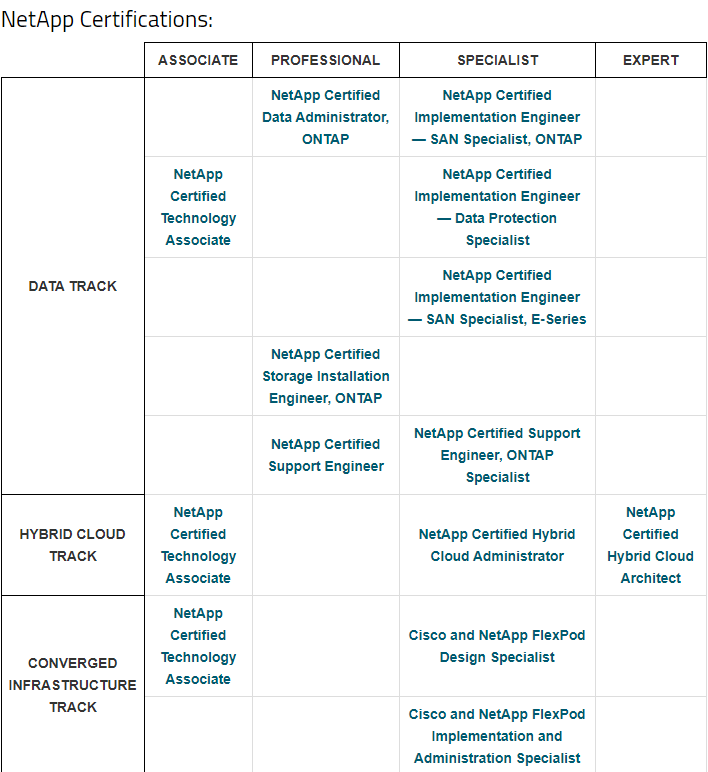New NS0-509 Dumps Have Been Verified As Valid Exam Dumps For 100% Passing
There are a lot of platforms providing the best and latest sample questions to pass NS0-509 exam but you must find the right one. The latest reviews of DumpsBase NS0-509 dumps, which updated on June 20, 2020 shown that new NS0-509 dumps are valid for 100% passing. We have verified that NS0-509 valid exam dumps contain real exam questions and answers, which are based on the exam objectives and exam points knowledge. If you are planning to start or improve your career with Network Appliance certification, you can choose to complete NS0-509 NetApp Certified Implementation Engineer - SAN, ONTAP certification exam with DumpsBase new NS0-509 dumps today.

NetApp NCIE SAM Specialist ONTAP NS0-509 Exam Can Still Be Registered
DumpsBase provide the high-quality Network Appliance NS0-509 exam dumps questions that will help you to be NetApp Certified Implementation Engineer—SAN Specialist ONTAP certified expert and have complete NS0-509 exam questions for you to learn about the questions of NetApp Certified Implementation Engineer SAN Specialist certification.
Network Appliance certifications provide industry validation of your skills as a NetApp technical professional. Get NetApp-certified to demonstrate your expertise, gain a competitive edge, build your resume, and step up to new opportunities. NetApp focuses on data storage and management, and is best known for its line of storage systems called NetApp filers. Currently, NetApp offers 14 certifications, broken into four levels across three certification tracks.

NetApp Certified Implementation Engineer—SAN Specialist is in data track as a specialist level certification. Getting the NetApp NCIE-SAN Specialist certification proves that you have skills in planning, implementing, integrating, and troubleshooting ONTAP SAN, FC switched fabrics and Ethernet iSCSI/FCoE solutions, and different operating systems (Windows, LINUX, ESX, UNIX) and applications. There are two credentials in NCIE-SAN Specialist certification:
●NCIE—SAN Specialist, ONTAP logos and certificates will be granted to those individuals who successfully pass NS0-161 exam and obtain NetApp Certified Data Administrator, ONTAP (NCDA ONTAP) certification, then pass the NetApp Certified Implementation Engineer—SAN (NS0-519 or NS0-509) exam.
Currently, both NS0-509 and NS0-519 exams can be registered for NCIE—SAN Specialist, ONTAP certification. They all can be available at Pearson VUE. However, NS0-509 exam will be retired soon, the new exam NS0-519 will be the only test for NetApp Certified Implementation Engineer—SAN Specialist ONTAP certification.
●NCIE—SAN Specialist, E-Series logos and certificates will be granted to those individuals who successfully pass the NetApp Certified Implementation Engineer—SAN, E-Series (NS0-515) exam.
NS0-509 Free Dumps Are Online For Helping Verify New NS0-509 Dumps By Yourselves
New NS0-509 dumps at DumpsBase are available in pdf file and testing engine. PDF version is file which you can print out to read and study all the NS0-509 dumps questions anywhere and anywhen. You can also use mobile phone, Pad to study them. It is very convenient. The testing engine is a simulation version, you can test NS0-509 dumps questions in real exam environment. At DumpsBase, the testing engine is for free. Before getting DumpsBase NS0-509 pdf file and the free testing engine, it is highly recommended to read NS0-509 Free Dumps online for verifying DumpsBase new NS0-509 dumps by yourselves.
NetApp Certified Implementation Engineer - SAN, ONTAP NS0-509 Free Dumps
You are testing iSCSI LUN failover across a 4-node FAS9000 fabric-attached MetroCluster configuration.
In this scenario, which front end configuration is required for nondisruptive host LUN failover between sites?
A. an intercluster LIF
B. a stretched Layer 2 network
C. IPv6
D. a stretched VSAN
Answer: A
You have a 4-node cluster with an AFF A300 HA pair and a FAS8200 HA pair. You plan on using the default storage efficiency settings. With inline data compaction, you estimate that you can save 6% of storage space. AFF A300 volumes that use under 5,000 IOPS are moved to a FAS8200 using the volume move command.
In this scenario, what happens to the data after the volume is moved? (Choose two.)
A. The new written data is not compacted.
B. The existing data is compacted.
C. The new written data is compacted.
D. The existing data is not compacted.
Answer: AB
A company has 20 ESX hosts. Ten of the hosts are connected using FC, and the rest are connected over iSCSI. The FC host HBA queue depth is set to 32, and the iSCSI LUN queue depth is set to 64. The FC hosts are now experiencing random connectivity issues.
In this scenario, what would be the reason for the disconnects?
A. The FC host has a lower queue depth.
B. According to the IMT, unsupported HBA firmware is in use.
C. All of the hosts are part of the same cluster.
D. The queue depth is not consistent across the cluster.
Answer: A
You want to ensure maximum performance of iSCSI LUNs on an AFF A220. In this scenario, which two actions will accomplish this task? (Choose two.)
A. Disable flow control.
B. Configure virtual LAN (VLAN).
C. Enable flow control.
D. Enable jumbo frames.
Answer: CD
You are provisioning storage to an ESX host that uses iSCSI. According to NetApp best practice, which three actions accomplish this task? (Choose three.)
A. Enable the iSCSI service.
B. Bind the iSCSI ports to the software iSCSI adapter.
C. Install Virtual Storage Console (VSC) for VMware.
D. Enable BGP on the switch.
E. Configure MTU 1500 on the switch.
Answer: BCE
You have a thin-provisioned LUN that was created by using the lun create -vserver vs1 -path /vol/vol1/lun1 -size 500G -ostype windows_2008 -space-reserve disabled -space¬allocation disabledcommand. You verify that your Windows 2016 host reports 200 GB free on lun1.
However, lun1 shows 0 bytes free on the storage cluster.
What should you do to solve this problem?
A. Change the LUN -space-allocationparameter to enabled.
B. Change the LUN -ostype parameter to windows_gpt.
C. Change the LUN -space-reserveparameter to enabled.
D. Rescan the LUN disk in your Windows host so that it will notify NetApp about the free space.
Answer: D
Which two features does Asymmetric Namespase Access (ANA) support? (Choose two.)
A. multipathing
B. LUN masking
C. LUN hosting
D. path management
Answer: AD
A customer that is using an AFF A220 has a problem with a host for a new FC LUN. Other LUNs on the same SVM are working properly. This LUN is not visible on the host.
Which configuration does the customer need to verify in their solution?
A. LUN mapping with igroup
B. host HBA speed settings
C. FC target port setting on NetApp node
D. FC switch zoning
Answer: C
A customer has an existing 8-node cluster that consists of six FAS2650 nodes and two FAS2554 nodes. The customer wants to expand the cluster by adding two AFF A220 nodes.
Which resource would be used to determine whether this configuration is supported?
A. Interoperability Matrix Tool (IMT)
B. Config Advisor
C. OneCollect
D. Hardware Universe (HWU)
Answer: B
You deployed a new SVM for FC access, and you used the vserver fcr, create -vserver svm1
-status-admin upcommand to enable FC service on the SVM. You then created the LIFs for the FC protocol. When you review the status of the LIFs, they show that the admin status is up, but the operational status is down. You have already verified that the ports are physically connected.
In this scenario, what is the next step to bring the LIFs up?
A. Use the network interface modifycommand to change the operational status of the LIFs.
B. Create at least one zone that contains your SVM LIF WWPNs and an initiator.
C. Verify that an FC license is applied on your system.
D. Disable the SAN switch port where your NetApp storage is connected.
Answer: B
